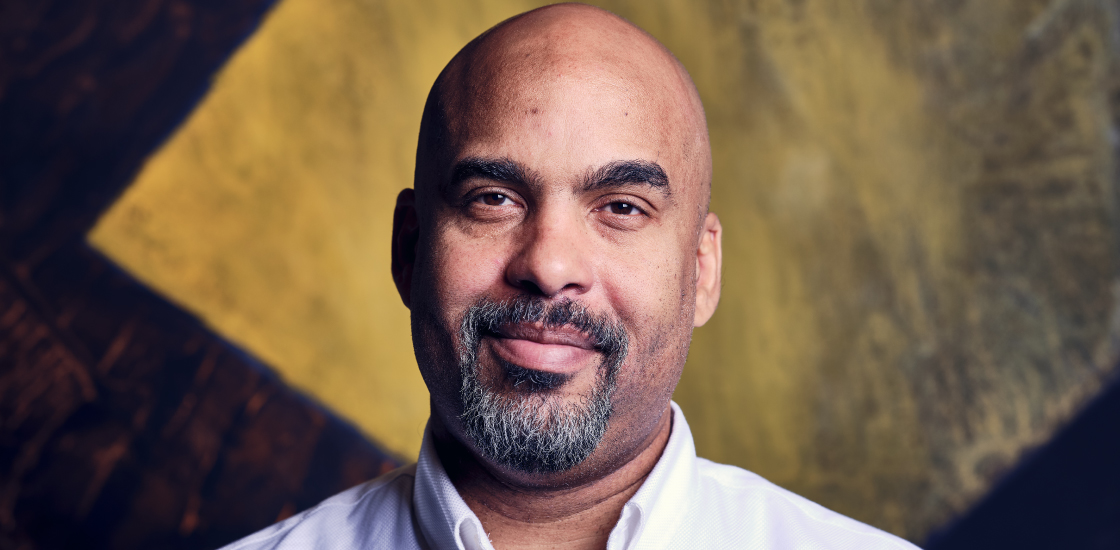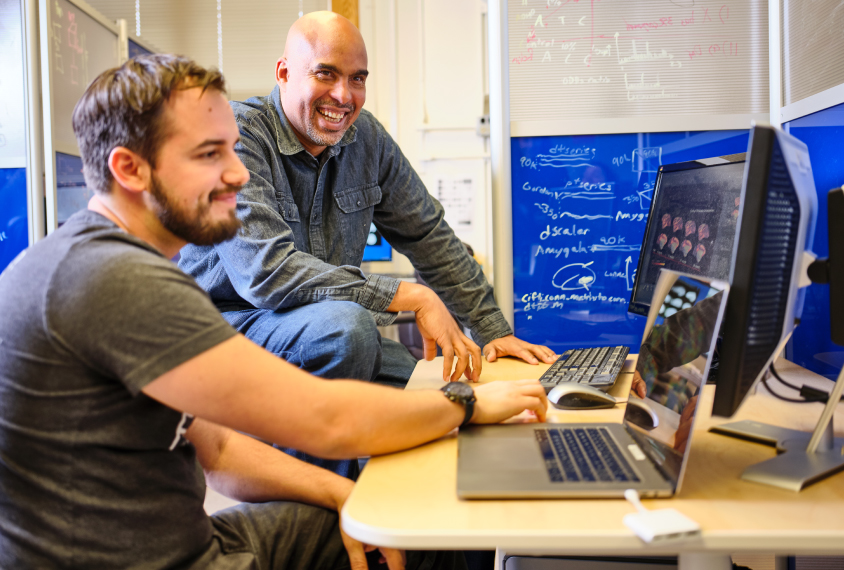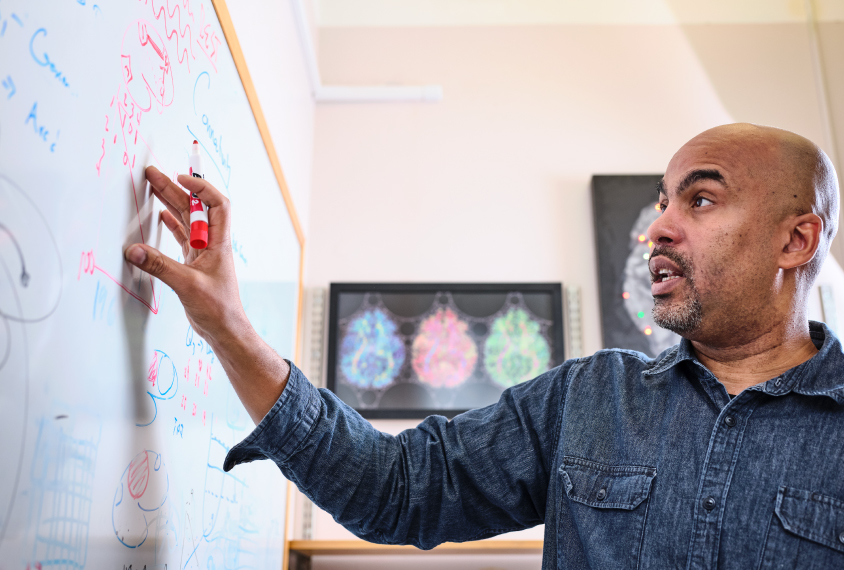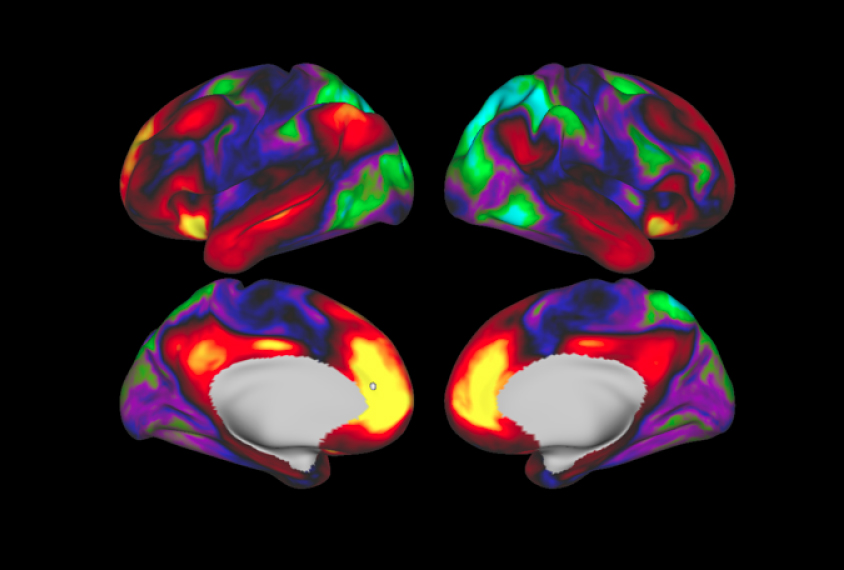Rising Star: Damien Fair, never at rest
Damien Fair has a knack for transforming obstacles into opportunities, a trait that has brought trailblazing discoveries and admiration from colleagues.

One day last April, Damien Fair chuckled along with the members of his 30-person lab at their monthly lunch meeting as he attempted to maneuver a bowl of soup, a plate of salad and a pair of crutches all at the same time. The associate professor of behavioral neuroscience at Oregon Health and Science University in Portland had broken his ankle in a city-league basketball game the evening before.
Fair waved away offers of help and soon got down to business. “All right, teach us something,” he told the lab members who were presenting their work that day. He mostly let the presenters, a graduate student and a research associate, hold the floor. Fair is tall and trim, with a salt-and-pepper goatee and expressive eyebrows. He laughed appreciatively at the visual puns in their PowerPoint presentation — for example, a photograph of a toddler in a wetsuit, a play on the name ‘FreeSurfer,’ software for analyzing brain scans.
“Damien never sweats anything — officially,” says Nico Dosenbach, assistant professor of pediatric neurology at Washington University in St. Louis, Missouri. Underneath his cool exterior, though, Fair is intense and driven, says Dosenbach, who has been Fair’s friend since the two were in graduate school. And Fair is not intimidated by conventional notions of status or rank: He doesn’t hesitate to ask other scientists for their data or time — or to offer his in return.
These traits have made Fair one of the most productive and sought-after collaborators in the field of brain imaging. “He attracts; he draws; he’s magnetic,” says Bradley Schlaggar, one of his graduate advisers.
Less than a decade after starting his lab, Fair has more than a dozen active grants, more than 80 peer-reviewed papers and nearly two dozen awards and fellowships, including a 2013 Presidential Early Career Award for Scientists and Engineers. Not all of his work deals directly with autism, but much of it has implications for understanding the condition.
Fair has made his biggest mark on the field through a type of brain scan known as resting-state functional magnetic resonance imaging (fMRI). The technique eavesdrops on a quiet brain to reveal which brain regions work together. Thanks in no small part to Fair’s efforts, resting-state research has yielded valuable information, shaping the notion of autism as a condition of brain connections gone awry.
One of Fair’s signature moves is the discovery of unique patterns of brain connectivity, analogous to fingerprints, that he calls ‘connectotypes.’ A scientific career is something like a connectotype. Every scientist makes connections, assembling a unique network that’s shaped by links inherited from mentors, then filled out with proteges and collaborators. Those connections can be many or few, reinforced and strengthened over time or left to wither. Fair’s network is unusually extensive and robust: His way of doing science has made him one of neuroscience’s most connected nodes.

Finding a path:
Fair was raised in Winona, Minnesota, about 100 miles down the Mississippi River from Minneapolis. His mother was a county court reporter and his stepfather, who raised him from early childhood, worked for the tech giant IBM. Fair attended a math-and-science magnet program in high school, then went to Augustana University (then known as Augustana College), a small liberal arts college in Sioux Falls, South Dakota, on a basketball scholarship. He still has a habit of repeating phrases with a kind of driving intensity that sounds borrowed from the sports world.
Fair was an indifferent student, a premedicine major who wasn’t sure he wanted to be a doctor. He took a year off after college and then entered a two-year physician-assistant training program at Yale University. There he met his wife, Rahel Nardos, in an anatomy class. (The couple has two children, and Nardos is a urogynecologist.)
At the end of that program, in 2001, Fair took a job in the neurology department of the Yale New Haven Hospital, working with stroke patients. The routine made him restless, but it did give him the opportunity to do research: “Now that was exciting, because we were coming up with our own ideas.”
So in 2003, Fair gave up medicine and became a graduate student in neuroscience at Washington University in St. Louis, working with Schlaggar and Steven Petersen. He set out to study how the brain rewires itself after experiencing a stroke in infancy, but his progress was slow. In retrospect, says Schlaggar, the imaging methods and analytical tools available at the time were not advanced enough.
Around that time, Fair and his fellow lab members were becoming interested in a cutting-edge brain imaging method: resting-state analysis.
Opening doors:
One day in 2005, Fair walked down the hall to the lab of Marcus Raichle, an eminent neurologist who had been developing resting-state analysis. He asked for the computer code Raichle’s team was using to analyze brain scans.
“I couldn’t believe that he had the guts to do that,” Dosenbach says.
Fair refined that code for one of the first proof-of-concept studies in resting-state analysis, which defined two distinct brain networks involved in attention1.
Fair also saw a way to mine traditional fMRI scans for resting-state information. These scans typically help researchers identify which brain areas activate when a person carries out a task, such as looking at faces or listening to music. Fair developed a method of stitching together the bits of the scan in between tasks while the participant rests quietly in the scanner.

Fair remembers his advisers being intrigued but skeptical of the resting-state technique. “We had these old-style workstations at the time, and when I had the first result, everybody came around,” he recalls. “There was clicking to see if these specific regions were talking to each other. It turns out that they were. Of course, my mentors were like: ‘I knew it!’” he says, laughing with good-natured triumph.
To make sense of the thousands of connections the analysis revealed, Fair borrowed concepts from advanced mathematics, such as graph theory, which models complex relationships as a network of connected nodes2.
One day in 2006, he emailed a famous mathematician, Steven Strogatz, who was scheduled to visit campus to give a lecture, and asked if Strogatz would meet with him and his advisers and fellow students. Fair’s advisers were gobsmacked at his audacity — but the email must have been persuasive, because Strogatz carved out a half hour in his schedule to meet the team. “It was incredibly fruitful,” Petersen says. “That opened whole new doors.”
Fair’s use of advanced mathematical techniques has had a significant impact on neuroscience beyond resting-state analysis, Petersen says. “He’s made people think about developmental cognitive neuroscience in this broader network way.”
Fair also pushed the limits of resting-state analysis. He was among the first to use the technique to investigate how brain networks develop, revealing that the networks become more defined as children grow up2. “This has been among the most reproduced findings in developmental neuroscience,” says Ted Satterthwaite, assistant professor of psychiatry at the University of Pennsylvania.
Achilles heel:
Around 2010, researchers discovered that resting-state studies have an Achilles heel: The tiny head movements that people make while lying in the scanner could skew the results. The problem is particularly acute among people with conditions such as autism, who tend to move a lot.
The revelations touched off a crisis in brain imaging. At the time, Fair was a postdoctoral fellow at Oregon Health and Science University, working with Joel Nigg and Bonnie Nagel to investigate the adolescent brain using resting-state scans. He had staked much of his career on this technique, and now the methodology seemed deeply flawed.
“Everybody was panicking,” Dosenbach says — but not Fair. “You just looked to Damien as sort of a source of inspiration because he’s cool as a cucumber.”
Fair instead set about trying to fix the problem, even though it meant delaying publication of some of his work3. “It’s courageous to do that, especially at the beginning of your career,” says Adriana DiMartino, a senior research scientist at the Child Mind Institute in New York who has collaborated with Fair.

Fair in fact made solutions to the movement issue part of his research portfolio. He and Dosenbach have launched a company to distribute software that monitors and corrects for movement; the software is in use by at least three dozen universities.
Fair has pioneered other ventures, too. He created a program called Youth Engaged in Science to help students from minority groups that are underrepresented in science. Members of Fair’s lab visit nearby schools to teach students about the brain. The program also places some of the high school and college participants as interns in labs at the university.
Meanwhile, Fair is using resting-state analysis to investigate developmental conditions such as attention deficit hyperactivity disorder and autism4. Earlier this year, his group reported that resting-state connectotypes are partially inherited and are stable over time, remaining recognizable as children grow up5. They plan to look for patterns in the connectotypes of people with autism, to see whether people with similar connectotypes have mutations in the same genes.
Fair has even finessed the fine points of resting-state imaging so that researchers can use it on animals, including mice and macaques.
“If he could do resting state on flies, he probably would,” Nagel says. “I mean, he collaborates with everybody who wants to do resting state. He’s kind of the go-to.”
References:
- Dosenbach N.U. et al. Proc. Natl. Acad. Sci. USA 104, 11073-11078 (2007) PubMed
- Fair D.A. et al. PLOS Comput. Biol. 5, e1000381 (2009) PubMed
- Fair D.A. et al. Front. Syst. Neurosci. 6, 80 (2013) PubMed
- Ray S. et al. Hum. Brain Mapp. 35, 6032-6048 (2014) PubMed
- Miranda-Dominguez O. et al. Netw. Neurosci. 2, 175-199 (2018) PubMed
Recommended reading

Among brain changes studied in autism, spotlight shifts to subcortex
Home makeover helps rats better express themselves: Q&A with Raven Hickson and Peter Kind
Explore more from The Transmitter

Dispute erupts over universal cortical brain-wave claim
Waves of calcium activity dictate eye structure in flies

